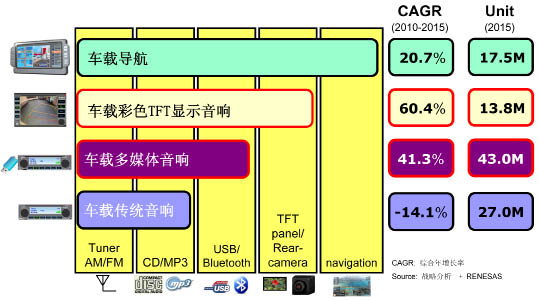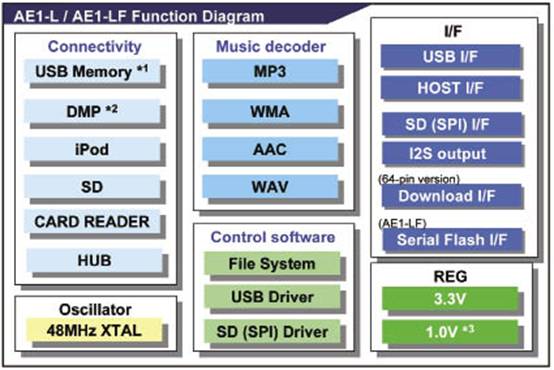In automotive electronics applications, many protocols such as CAN, LIN, MOST, and Bluetooth, drive systems, chassis, security systems, dashboards, and more are required. Car audio and car navigation are also important links.
In-vehicle infotainment system trends
Traditional car audio includes Tuner and radio, and CD playback. As people's needs are more and more, they may add functions such as USB devices and Bluetooth devices. Slowly, people find that it is not enough to "listen". Video, camera features, and then need navigation. Among them, as shown in Fig. 1, the annual growth rate of the car color TFT display audio and the car multimedia audio is the highest. 
Figure 1 In-vehicle infotainment system trends
Multimedia features are enhanced every year, as shown in Figure 2. For multimedia functions, the first is just CD playback or support for USB or SD card, etc. Slowly with the popularity of the iPod, you need to support the iPod function and iPod Bluetooth, including USB3.0. The color TFT from the WQVGA to VGA display, to the RD display and finally connected to the Smart Phone display, it is not difficult to find, the function will be more and more enhanced.
The car multimedia audio system module is shown in Figure 3. It consists of a Tuner, CD DSP server USB module and iPod function controlled by a master MCU. 
Figure 2 The function of the car infotainment system 
Figure 3 multimedia audio function module
Here, the multimedia audio functions are AM/FM; CD, USB, SD, iPod, Bluetooth; MP3, WMA, AAC; Character Display.
AE1-L inorganic core car audio solution
AE1-L is the Renesas electronic inorganic core car audio solution. After the traditional car audio uses AE1-L, as shown in Figure 4, you can directly add audio decoding (MP3/WMA/AAC) and USB/SD interface, and you can remove the CD movement and transform into Low Cost Car Audio (LCC). Audio). This can be turned into a low-cost audio solution. The flexibility of this solution is very good, to meet the different needs of different customers.
The AE1-L product block diagram is shown in Figure 5. From the perspective of connectivity, AE1-L supports USB Memory, DMP, iPod, SD, CARD READER, HUB, etc. The supported audio includes MP3, WMA, AAC, WAV, The AE1-L also has control elements inside, which can be used for file system analysis, USB drive and SD drive. From the interface, it can support USB I/F, HOST I/F, SD (SPI) I/F, I2S output, Download I/F (64-pin version), and Serial Flash I/F (AE1-LF). .
The AE1-L is divided into five product lines, which are divided into standard and car gauge grades, and are packaged into 48-pin and 64-pin. Among them, AE1-L has 3 products that do not need external flash. AE1-LF has 2 products that can support external Flash self-upgrade function. For example, if you have iPod function, you can use external flash to AE1 when the iPod protocol is changed. -LF is upgraded to support the latest protocols, self-upgrading, and full-line support for self-upgrade of MCU functions.
The 64-pin AE1-L supports the data download function. In addition to reading music files via USB memory and SD card, it can also transfer specific files and transfer picture data for external graphic display or analysis by external MCU. Features.
Another significant feature is the MCU self-upgrade function. The MCU can read the external code system of the external USB or SD device through AE1-L to realize the self-upgrade function of the main controller.
The AE1-L feature is easy to control, is a simple design of USB memory / iPod / SD audio system, and also has low-cost features, is a cost-optimized connected audio. At the same time, a small area system layout can be achieved. The AE1-L is available in two sizes, 48-pin and 64-pin, with a 48-pin package size of 7mm x 7mm and a 64-pin package size of 10mm x 10mm. Customers can easily add AE1-L to existing audio player solutions.
The new SoCs integrate USB host controller and audio decoding, so single-chip SoCs can play music directly from USB devices, SD cards and other digital music players. Extensions can be implemented in external Flash. 
Figure 4 Traditional car audio using AE1-L 
Figure 5 AE1-L product block diagram
AE1-L has a variety of product features. USB 2.0 (FS) host interface; rich connectivity including USB memory, SD card, iPod and other music players; HUB/card reader; features include plug-and-play, built-in software and middleware, upgradeable, no Development tools are required; support for multiple audio formats including MP3/WMA/AAC/WAV; feature updates include AE1-L (with internal ROM, no external Serial Flash required), AE1-LF (with external Serial Flash, software can be upgraded at any time) .
Simple and easy to control is also the AE1-L feature, which can be used to control AE1-L through the MCU. Renesas Electronics developed programs for the MASK version and the external FALSH version; compressed audio decoding (MP3/WMA/AAC); USB host driver; SD driver (SPI); USB file system (FAT16/32); system with I/F Controller (API); audio playback (play, stop, random, etc.). On the existing MCU S/W, the customer only needs to add the AE1-L control command to complete.
The AE1-L development tool consists of three parts: file, schematic and firmware. The documentation includes data sheets and user manuals as well as application notes. The schematic includes the schematic and PCB layout of the demonstration board. The firmware includes the MCU code (78K0 and R8C) of the demonstration board.
AE1-L demonstration board
AE1-L HDK main features:
• MCU–R8C/2A, clock frequency 20MHz, ROM 64KB, RAM 3kB
• Audio chip – audio decoding
• Display device – OLED 256 pixels × 64 pixels, support Chinese and English text display
• Input interface – 2 knobs (with 1 button each), 6 buttons
• Storage media – support U disk, SD card
• Audio output – 4 channel output, 1 headphone output
• Audio format – supports MP3, AAC, WMA, WAV formats
The AE1-L (μPD63911/uPD63551/uPD63531) and AE1-LF (μPD63530/ μPD63910) are audio decoder SoCs that integrate a USB (Universal Serial Bus) host controller. Suitable for automotive and consumer electronics applications such as digital car audio. The USB 2.0 (full speed 12Mbps) host controller and the functions required for the USB audio system are integrated on a single chip. Its built-in standard integration software includes: USB control, MP3, WMA and AAC decoding, WAV file playback, file system control and system control. User-developed applications simply send simple control commands. This greatly reduces the time required for development.
Driver for MCU internal modules:
•Clock
• Timer0, Timer1, Timer2
• CSI0 (for communication between MCU and AE1-LF)
• CSI1 (for MCU and Serial Flash communication)
• I2C (for communication between MCU and E-Volume)
• Port (Key/ Rotary encoder/ LED
• reset control/ power control)
• related interruptions, etc.
Peripheral peripheral drivers: AE1-L, OLED, E-Volume, Serial Flash (character, LOG, various graphic identifiers, user-set parameters, resume playback information).
The interface content is abstracted peripheral functions and APIs for accessing peripherals, namely AE1-L, Display, E-Volume, Serial Flash (design storage font, LOG, various graphic identifiers, user setting parameters, etc.).
System services include application services (Clock, Timer) and error status management.
Through the task management, each function is realized. The main tasks include: Host task (responsible for managing device status), AE1-L task (implementing AE1-L function (storage media access, audio decoding)), Display task (displaying human-computer interaction information in various states), E- Volume task (manage audio properties).
The event and the information flow are expressed as: when an event occurs, including a button or a knob, and classified according to the receiving object, the message type is divided into a message received by the AE1-L module, a message received by the Display module, and a message received by the E-Volume module. It is worth noting that the Host module only sends messages and does not need to receive messages sent by other modules. The Display module only receives messages. The AE1-L module and the E-Volume module are sent according to different occasions and functions. Fang, is also the recipient of some other news.
The MCU system clock selects two clock sources according to different operating states: In the Power on state, the MCU system clock uses an on-chip high-speed clock, which is about 40 MHz (the MCU internally has a fixed divide-by-2).
In the Power down state, the MCU system clock uses an on-chip low-speed clock, approximately 125kHz. It is worth noting that the two communication modes (clock synchronous serial communication and I2C communication) used by the MCU are comprehensively considered, and the on-chip high-speed clock accuracy (about 2% at normal temperature) is selected, and the on-chip high-speed clock is selected in the Power on state. The low power consumption uses an on-chip low-speed clock, and the current consumption is 145μA with a 3.3V supply/8 division.
Host's main functions are system management, master state management; interpreting Key and Encoder events, and generating corresponding messages; scheduling other small services such as saving and reading setup parameters, LED display, Watchdog, etc.
The HDK provides three controllable power supplies for peripheral devices, 12V/5V/3.3V. In the Power down state, turn off the peripheral device power to reduce power consumption. The MCU has low power consumption and uses an on-chip low-speed clock (about 125 kHz). In theory, R8C2A has a current consumption of 145μA under the condition of "VCC=3V, system clock is on-chip low-speed clock, divide-by-8".
To improve system reliability, the Watchdog timeout reset function is used. When the system clock is an on-chip high-speed clock (in the Power up state), the Watchdog timing is approximately 209ms. When the system clock is an on-chip low-speed clock (in the Power down state), the Watchdog timing is approximately 512ms.
At present, the software occupies MCU resources with ROM Code 40kBytes; ROM Data 11k Bytes; RAM 2kBytes.
This article refers to the address: http://
Our Led Industrial Lighting are designed to provide optimal lighting for factories,warehouse,manufacturing plants,distribution centers,parking garages and gyms.etc..We have Led High Bay for indoor use,and UFO high bay with IP65 for outdoor use.Our main technology is in the radiating fins design.The riveting process for the radiator plate and fins is mainly installed in the mold fixture,each module comprise a plurality of fins,and with a predetermined gap between adjacent fins,and the fins can be inserted into the positioning mould,by interlacing the fins and the adjacent punch,the plate is with trench to positioning in metallurgical equipment,stamping equipment impact the back of the base plate to make the fins riveting consolidation,Through the implementation of the above technology,the stamping riveting method is better than the traditional radiator processing,it is highly effective and reduce the mould broken, and provide precision and high quality products.
Led Industrial Lighting
Led Industrial Lighting,Led Industrial Light,Industrial Outdoor Lighting,Industrial Led Lighting
Guangdong guangzhidian lighting Co., Ltd. , https://www.gzdlighting.com